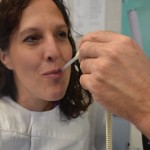2.3: Vital Signs
- Page ID
- 9989
Temperature, pulse, respiration, blood pressure (BP), and oxygen saturation, are measurements that indicate a person’s hemodynamic status. These are the five vital signs most frequently obtained by health care practitioners (Perry, Potter, & Ostendorf, 2014). Vital signs will potentially reveal sudden changes in a patient’s condition and will also measure changes that occur progressively over time. A difference between patients’ normal baseline vital signs and their present vital signs may indicate the need for intervention (Perry et al., 2014). Checklist 15 outlines the steps to take when checking vital signs.
Checklist 15: Vital SignsDisclaimer: Always review and follow your hospital policy regarding this specific skill. |
|||
Steps |
Additional Information |
||
|
1. Temperature:
|
Normal (oral) = 35.8ºC to 37.3ºC Oral temperature: Place the thermometer in the mouth under the tongue and instruct patient to keep mouth closed. Leave the thermometer in place for as long as is indicated by the device manufacturer. Axillary temperature: Usually 1ºC lower than oral temperature. Place the thermometer in patient’s armpit and leave it in place for as long as is indicated by the device manufacturer. Tympanic membrane (ear) temperature: Usually 0.3°C to 0.6°C higher than an oral temperature. The tympanic membrane shares the same vascular artery that perfuses the hypothalamus. Do not force the thermometer into the ear and do not occlude the ear canal. Rectal temperature: Usually 1ºC higher than oral temperature. Use only when other routes are not available. |
||
|
2. Pulse: Normal resting heart rate = 60 to 100 beats per minute 
Radial pulse 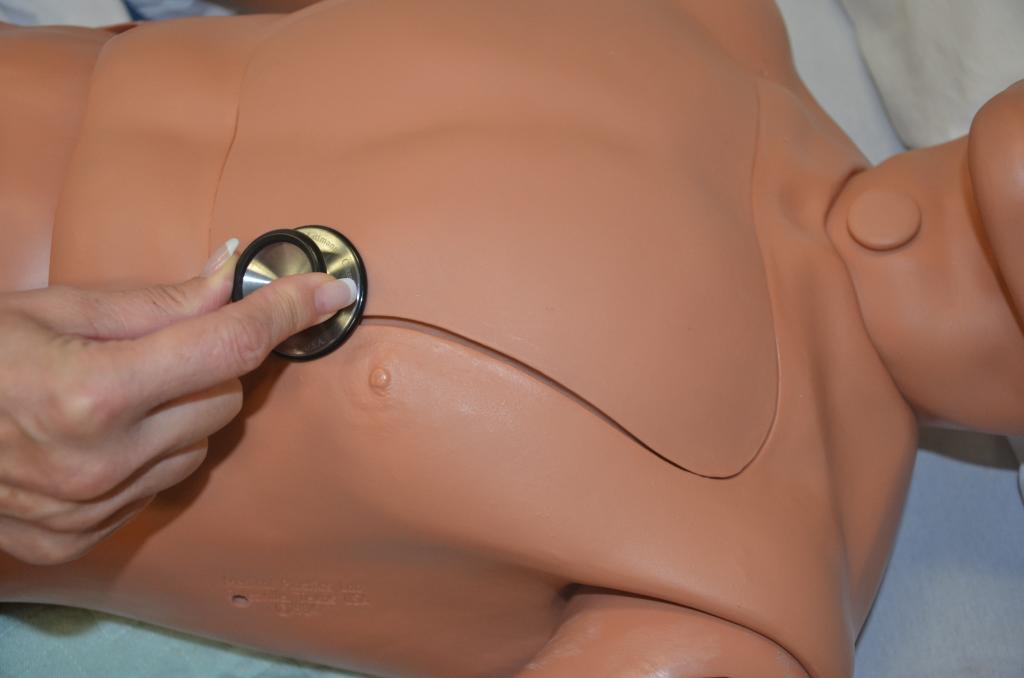
Apical pulse |
Radial pulse: Use the pads of your first three fingers to gently palpate the radial pulse at the inner lateral wrist. Apical pulse: Taken as part of a focused cardiovascular assessment and when the pulse rate is irregular. Apical heart rate should be used as the parameter indicated in certain cardiac medications (e.g., digoxin). Apical pulse rate should be taken for a full minute for accuracy, and is located at the fifth intercostal space in line with the middle of the clavicle in adults. Carotid pulse: May be taken when radial pulse is not present or is difficult to palpate. |
||
|
3. Respiration rate: Normal resting respiratory rate = 10 to 20 breaths per minute 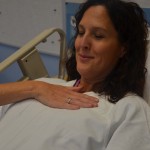
Respiratory rate |
Count respiratory rate unobtrusively while you are taking the pulse rate so that the patient is not aware that you are taking the respiration rate. Count for 30 seconds or for a full minute if irregular. | ||
|
4. Blood pressure (BP): 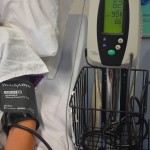
Blood pressure cuff The average BP for an adult is 120/80 mmHg, but variations are normal for various reasons. |
The systolic pressure is the maximum pressure on the arteries during left ventricular contraction. The diastolic pressure is the resting pressure on the arteries between each cardiac contraction. The patient may be sitting or lying down with the bare arm at heart level. Palpate the brachial artery just above the antecubital fossa medially. Wrap the BP cuff around the upper arm about 2.5 cm above the brachial artery. Palpate the radial or brachial artery, and inflate the BP cuff until the pulse rate is no longer felt. Then inflate 20 to 30 mmHg more. Place the bell of the stethoscope over the brachial artery, and deflate the cuff slowly and evenly, noting the points at which you hear the first appearance of sound (systolic BP), and the disappearance of sound (diastolic BP). |
||
|
5. Oxygen saturation (SpO2): A healthy patient will have an SpO2 of ≥ 97%. 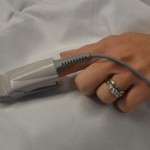
Pulse oximeter sensor |
A pulse oximeter sensor attached to the patient’s finger or earlobe measures light absorption of hemoglobin and represents arterial SpO2. | ||
| Data source: Jarvis et al., 2014; Stephen, Skillen, Day, & Jensen, 2012 | |||
Critical Thinking Exercises
- Which type of thermometer is the best example of a non-invasive, safe, and efficient tool for measuring temperature?
- A 40-year-old male patient has a blood pressure of 140/100 mmHg. Is this normal for this patient? What additional data would you need to collect before making a decision about care for this patient?


